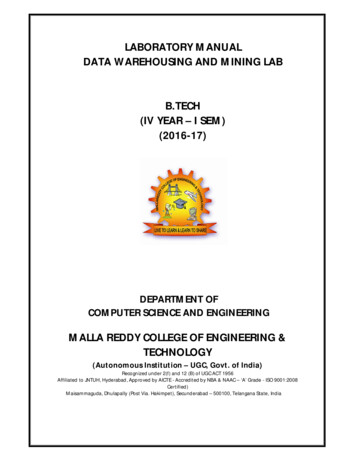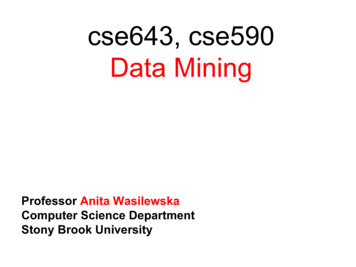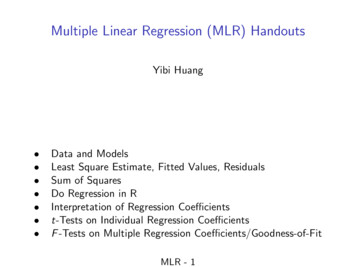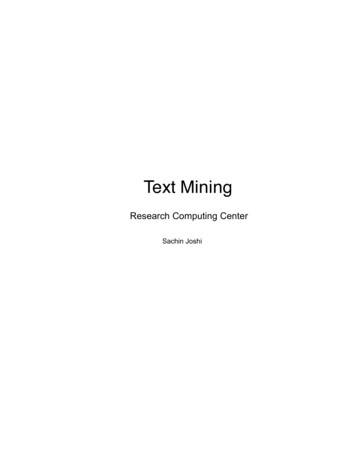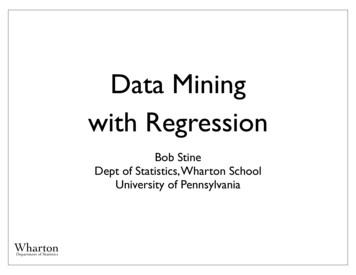
Transcription
Data Miningwith RegressionBob StineDept of Statistics, Wharton SchoolUniversity of PennsylvaniaWhartonDepartment of Statistics
Some Details Office hours Let me know and we can meet at Newberry stine@wharton.upenn.edu Class notes http://www-stat.wharton.upenn.edu/ stine/mich/ Data Will post ANES and others on Z drive JMP software Depends on your schoolWhartonDepartment of Statistics2
Topics for Today Review from last time Any questions, comments? Growing regression models Deciding which variables improve a model Standard errors and significance Missing data Stepwise regressionWhartonDepartment of Statistics3
Why use regression? Claim Regression is capable of matching the predictiveperformance of black-box models Just a question of having the right X’s Regression is familiar Recognize then fix problems Shares problems with black-boxesOpportunity to appreciate what happens in less familiar,more complex models with more flexible structure. Familiarity allows improvements Patches in Foster and Stine 2004WhartonDepartment of Statistics4
Review ANES Example Start with simple regr, expand to multiple Post FT Obama on Pre FT Obama Add ‘Happy/Sad’ and ‘Care Who Wins’ Include interaction effect Visual exploration of model form Show the effects of an interaction What’s the interaction mean Calibration Being right on averageprofilingavg(Y Ŷ) Ŷ Tests and inference Which terms are significant? What’s that mean?WhartonDepartment of Statistics5
Modeling Question How do we expand a regression model Reach beyond obvious variables Find subtle but important features Automate typical manual procedure Iterative improvement Try variable, diagnose, try another, diagnose Computing allows more expansive search Open modeling process to allow a surprise Example: Include interactionstransformations, combinations (e.g. ratios), bundles (e.g. prin comp)WhartonDepartment of Statistics Magnified scope also magnifies problems6
Medical Example Numerical response Diagnosing severity of osteoporosis Brittle bones due to loss of calcium Leads to fractures and subsequent complications Personal interest Response X-ray measurement of bone density Standardized to N(0,1) for normal Possible to avoid expense of x-ray, triage? Explanatory variables Data set designed by committeedoctors, biochemists, epidemiologistsWhartonDepartment of Statistics7
Osteoporosis Data Sample of postmenopausal women 1,232 women with 127 columnsNursing homes in NE Dependence? Bias?Presence of missing dataideal data?Measurement error Marginal distributions X-ray scores (zHip), weight, age.WhartonDepartment of Statistics8
Initial Osteo Model Simple regression zHip on which variable? How would you decide WhartonDepartment of StatisticsImpact of weightpick largest correlationconsult scienceInterpretation?9
Expanding Model What to add next? Residual analysis Add others and see what sticks Add them all? Singularities imply redundant combinations Summary of fitImpressive R2 until you look at the sample size.WhartonDepartment of Statistics10
Missing Data Fit changes when add variables Collinearity among explanatory variables Different subsets of cases What to do about the missing cases Exclude“Listwise deletion”“Pairwise deletion” Impute. Fill them in, perhaps several times Imputation relies on big assumptionMissing cases resemble those included.WhartonDepartment of StatisticsReal data is seldom (if ever)missing at random11
Handle Missing Data Add another variable Add indicator column for missing values Fill the missing value with average of those seen Simple, reduced assumption approach Expands the domain of the feature search Allows missing cases to behave differently Conservative evaluation of variable Part of the modeling processLeads to complaintsabout lack of power Distinguish missing subsets only if predictive Categorical: not a problem Missing form another categoryWhartonDepartment of Statistics12
Example of Procedure Simple regression, missing at random Conservative: unbiased estimate, inflated SE n 100, β0 0, β1 3 30% missing at random, β1 3Complete4020b0b10-40-10Department of StatisticsSE1.00.17Filled 0.2713
Example of Procedure Simple regression, not missing at random Conservative: unbiased estimate, inflated SE n 100, β0 0, β1 3 30% missing follow steeper line8060Requires robust 40variance estimate20Filled In0-20WhartonDepartment of Statistics-10-50510b0b1Est-0.022.82SE2.60.4414
Example from RData frame withmissing valuesFilled in data with addedindicator columnsNo cheating:You don’t get to fill in the y’s!WhartonDepartment of Statisticsmissing data.R15
Background of Procedure Been around for a long time Well suited to data mining when need to searchfor predictive features Reference Paul Allison’s Sage monograph on Missing Data(Sage # 136, 2002). For a critical view, see Jones, M. P. (1996) J Amer. Statist. Assoc., 91, 222–230 He’s not too fond of this method, but he modelsmissing data as missing at random.WhartonDepartment of Statistics16
Expanded Osteo Data Fill in missing data Grows from 126 to 208 possible Xs Saturated model resultsDo in R Full sample but so few significant effectsStill missing interactionsWhartonDepartment of Statistics17
Stepwise Regression Need a better approach Cannot always fit the saturated model Saturated model excludes transformations suchas interactions that might be useful Mimic manual procedure Find variable that improves the current modelthe most Add it if the improvement is significant. Greedy search Common in data mining with many possible X’s One step ahead, not all possible models Requires caution to use effectivelyWhartonDepartment of Statistics18
Stepwise Example Predict the stock market Response Daily returns (essentially % change) in the S&P500 stock market index through April 2014 Goal Predict returns in May and June using data fromJanuary through April WhartonDepartment of StatisticsExplanatory variablescup-and-handle 15 technical trading rules based onobserved properties of the market Designed to be easy to extrapolate19
Results Model has quite a few X’s but is verypredictive and highly stat significant.WhartonDepartment of StatisticsResiduals diagnostics check out fine.20
Predictions Plot of predictions with actual Fit anticipates turning points.WhartonDepartment of Statistics21
Evaluating the Model Compare claimed to actual performance R2 89% with RMSE 0.0032 How well does it predict May and June? SD of prediction errors much larger thanmodel claimed 2 RMSEWhartonDepartment of StatisticsWhat wentwrong?22
Forward Stepwise Allow all possible interactions, 135 possible Start with 15 X’sAdd 15 squares of X’sAdd 15*14/2 105 interactionsPrinciple of marginality?Response surfacein JMP Forward search Greedy search says to add most predictive Problem is when to stop? Use statistical significance?WhartonDepartment of Statistics What threshold for the p-value? Follow convention and set α 0.05 or larger?23
Explanation of Problem Examine the definition of the technicaltrading rules used in the model Why did the stepwise get this so wrong? Problem is classic example of over-fitting Tukey “Optimization capitalizes on chance” Problem is not with stepwise Rather it lies with our use of classical statistics α 0.05 intended for one test, not 135WhartonDepartment of Statistics24
Over-Fitting Critical problem in data mining Caused by an excess of potential explanatoryvariables (predictors)error Claimedsteadily shrinks with size of the model“Over-confident”over-fitting Model claims topredict new casesbetter than it will. ChallengeWhartonDepartment of Statistics Select predictors that produce a model thatminimizes the prediction error without over-fitting.25
Problem in Sciencexkcd Source ofpublication biasin journals Statistics rewardspersistenceWhartonDepartment of Statistics26
How to get it right? Three approaches Avoid stepwise (and similar methods) altogether Reserve a validation sample (cross-validation) Be more choosy about what to add to model Bonferroni rule Set the p-value based on the scope of the search Searching 135 variables, so set the threshold to0.05/135 0.00037 Result of stepwise search?WhartonDepartment of StatisticsBonferroni gets it right Nothing is added to the model!27
Take-Aways Missing data Fill in with an added indicator for missingness Over-fitting Model includes things that appear to predict theresponse but in fact do not Stepwise regression Illustrative greedy search for features that mimicswhat we do manually when modeling Expansive scope that includes interactions Bonferroni: Set p-to-enter 0.05/(# possible)WhartonDepartment of Statistics28
Assignment Missing data What do you do with them now? Try doing stepwise regression with yourown software. Does your software offer robust varianceestimates (aka White or Sandwich estimates) Take a look at the ANES dataWhartonDepartment of Statistics29
Next Time Review of over-fitting What it is and why it matters Role of Bonferroni Other approaches to avoiding over-fitting Model selection criteria: AIC, BIC, Cross-validation Shrinkage and the lassoWhartonDepartment of Statistics30
Well suited to data mining when need to search for predictive features Reference Paul Allison's Sage monograph on Missing Data (Sage # 136, 2002). For a critical view, see Jones, M. P. (1996) J Amer. Statist. Assoc., 91, 222-230 He's not too fond of this method, but he models missing data as missing at random. 16




